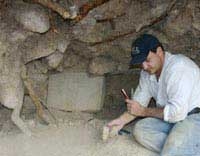A new dinosaur species has been identified as a bipedal herbivore, distinguished by its unique downward-curving tail, unlike other dinosaurs with horizontal tails.
Argentinian paleontologists have announced the discovery of fossils belonging to a new medium-sized herbivorous dinosaur that had the ability to run quickly. This species lived approximately 90 million years ago during the Cretaceous period in what is now Patagonia, an area straddling Argentina and Chile.

Fossil of the dinosaur Chakisaurus nekul. (Source: GMA Network).
With support from the National Geographic Society, Argentinian paleontologists began their research in 2018, recently publishing their findings in the journal *Cretaceous Research*.
According to the research, this dinosaur species is named Chakisaurus nekul, with the largest individuals estimated to measure between 2.5 to 3 meters in length and stand about 70 cm tall.
The fossils were discovered in the Pueblo Blanco Nature Reserve in Río Negro Province, Southern Argentina, an area known for its rich deposits of mammal, turtle, and fish fossils, alongside various other dinosaur species.
Paleontologists suggest that this new discovery indicates a dinosaur capable of fast running, characterized by its uniquely downward-curving tail.
Rodrigo Álvarez, the lead researcher, noted that this new dinosaur species is a bipedal herbivore, with its most significant feature being the downward-curving tail, in contrast to other dinosaurs that had horizontal tails.
The expert emphasized that this discovery is a significant addition to the understanding of this type of animal. Moreover, Chakisaurus nekul was able to run very fast, a trait essential for self-defense and survival amidst predatory species.
Co-author Sebastián Rozadilla added that Chakisaurus nekul possessed strong hind limbs and a tail capable of lateral movement, allowing it to maintain balance during chases.





















































